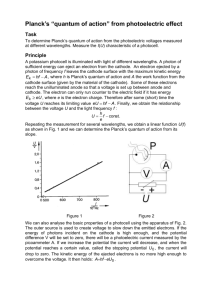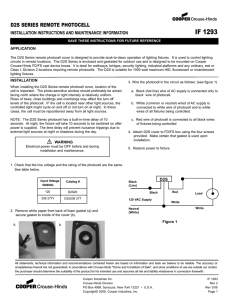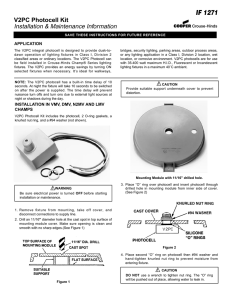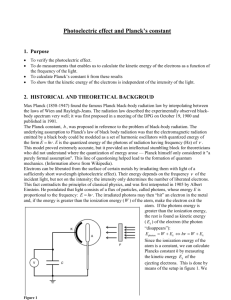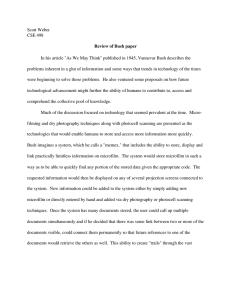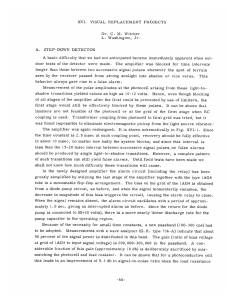IF 1308 EV2IH EXPLOSIONPROOF PHOTOCELL INSTALLATION INSTRUCTIONS AND MAINTENANCE INFORMATION APPLICATION
advertisement
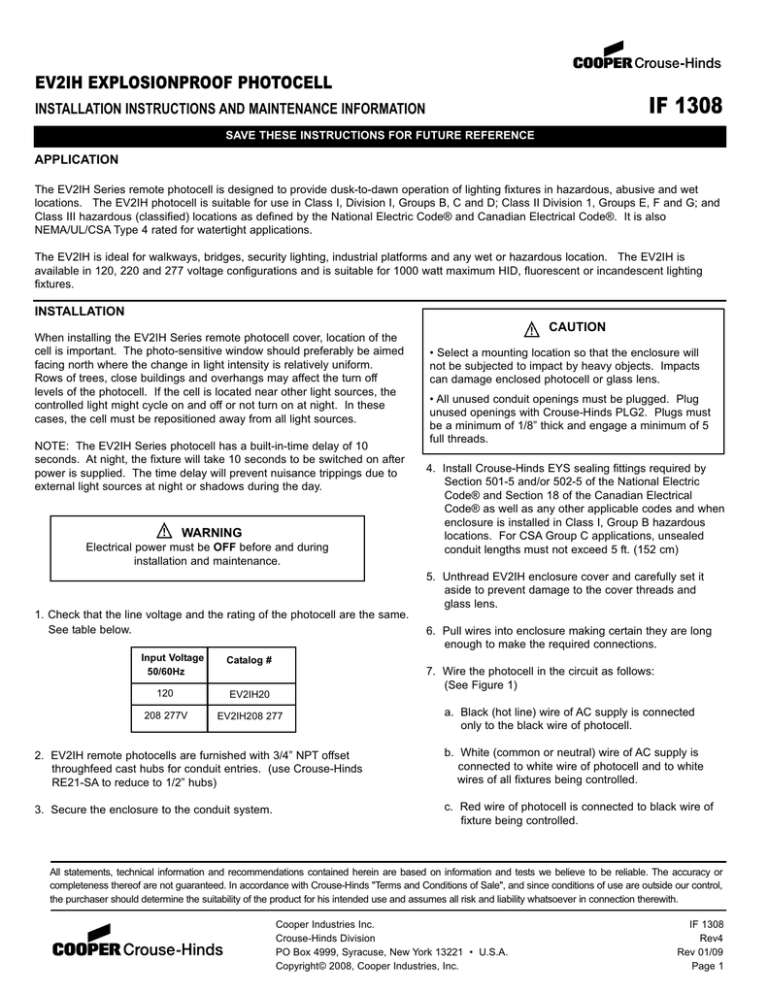
EV2IH EXPLOSIONPROOF PHOTOCELL IF 1308 INSTALLATION INSTRUCTIONS AND MAINTENANCE INFORMATION SAVE THESE INSTRUCTIONS FOR FUTURE REFERENCE APPLICATION The EV2IH Series remote photocell is designed to provide dusk-to-dawn operation of lighting fixtures in hazardous, abusive and wet locations. The EV2IH photocell is suitable for use in Class I, Division I, Groups B, C and D; Class II Division 1, Groups E, F and G; and Class III hazardous (classified) locations as defined by the National Electric Code® and Canadian Electrical Code®. It is also NEMA/UL/CSA Type 4 rated for watertight applications. The EV2IH is ideal for walkways, bridges, security lighting, industrial platforms and any wet or hazardous location. The EV2IH is available in 120, 220 and 277 voltage configurations and is suitable for 1000 watt maximum HID, fluorescent or incandescent lighting fixtures. INSTALLATION When installing the EV2IH Series remote photocell cover, location of the cell is important. The photo-sensitive window should preferably be aimed facing north where the change in light intensity is relatively uniform. Rows of trees, close buildings and overhangs may affect the turn off levels of the photocell. If the cell is located near other light sources, the controlled light might cycle on and off or not turn on at night. In these cases, the cell must be repositioned away from all light sources. NOTE: The EV2IH Series photocell has a built-in-time delay of 10 seconds. At night, the fixture will take 10 seconds to be switched on after power is supplied. The time delay will prevent nuisance trippings due to external light sources at night or shadows during the day. WARNING Electrical power must be OFF before and during installation and maintenance. CAUTION • Select a mounting location so that the enclosure will not be subjected to impact by heavy objects. Impacts can damage enclosed photocell or glass lens. • All unused conduit openings must be plugged. Plug unused openings with Crouse-Hinds PLG2. Plugs must be a minimum of 1/8” thick and engage a minimum of 5 full threads. 4. Install Crouse-Hinds EYS sealing fittings required by Section 501-5 and/or 502-5 of the National Electric Code® and Section 18 of the Canadian Electrical Code® as well as any other applicable codes and when enclosure is installed in Class I, Group B hazardous locations. For CSA Group C applications, unsealed conduit lengths must not exceed 5 ft. (152 cm) 5. Unthread EV2IH enclosure cover and carefully set it aside to prevent damage to the cover threads and glass lens. 1. Check that the line voltage and the rating of the photocell are the same. See table below. Input Voltage 50/60Hz 6. Pull wires into enclosure making certain they are long enough to make the required connections. Catalog # 7. Wire the photocell in the circuit as follows: (See Figure 1) 120 EV2IH20 208 277V EV2IH208 277 a. Black (hot line) wire of AC supply is connected only to the black wire of photocell. 2. EV2IH remote photocells are furnished with 3/4” NPT offset throughfeed cast hubs for conduit entries. (use Crouse-Hinds RE21-SA to reduce to 1/2” hubs) b. White (common or neutral) wire of AC supply is connected to white wire of photocell and to white wires of all fixtures being controlled. 3. Secure the enclosure to the conduit system. c. Red wire of photocell is connected to black wire of fixture being controlled. All statements, technical information and recommendations contained herein are based on information and tests we believe to be reliable. The accuracy or completeness thereof are not guaranteed. In accordance with Crouse-Hinds "Terms and Conditions of Sale", and since conditions of use are outside our control, the purchaser should determine the suitability of the product for his intended use and assumes all risk and liability whatsoever in connection therewith. Cooper Industries Inc. Crouse-Hinds Division PO Box 4999, Syracuse, New York 13221 • U.S.A. Copyright© 2008, Cooper Industries, Inc. IF 1308 Rev4 Rev 01/09 Page 1 Installation cont’d Photocell 8. Carefully rethread the cover to enclosure housing. Tighten cover until flange contacts body face. EV2IH Black (Line) CAUTION Red Black Use care to prevent dirt, grit or other other foreign material from lodging on threads. If any such material settles on these threads, clean them with kerosene or Stoddard Solvent, then relubricate with Crouse-Hinds Type STL thread lubricant. 120 VAC Supply Load White White Neutral (White) Figure 1 9. Restore power to fixture. WARNING Always disconnect primary power source before opening fixture for inspection or service. MAINTENANCE 1. Frequent inspections should be made. A schedule for maintenance checks should be determined by the environment and frequency of use. It is recommended that inspections should be performed at least once a year. 2. Visually check for damaged parts, undue heating evidenced by discoloration of wires or other components, leakage evidenced by water or corrosion in the interior and proper lamp operation. 3. The photocell window and the EV2IH glass cover must be clear in order to work properly. To clean, wipe with a clean damp cloth. If this is not sufficient, use a mild soap or liquid non-abrasive cleaner which will not scratch the window. PHOTOCONTROL TROUBLE-SHOOTING Problem Load stays off Load stays on Load blinks at night and remains off during the day Load blinks during the day and remains on at night The fuse blows when power is supplied Cause 1. 2. 3. 4. Line voltage too high Photocell not rated for supply voltage Incorrect wiring External lights striking photocell Solution 1. 2. 3. 4. Correct voltage and replace photocell Replace control with one having proper rating Check wiring diagram Reposition photocell 1. Line voltage too low 2. Photocell not rated for supply voltage 3. Not enough light striking window during daylight 4. Contacts of photocell welded due to excessive load 5. Incorrect wiring 1. Correct voltage and replace photocell 2. Replace control with one having proper rating 3. Reposition photocell in direction of more light 1. Light from load is directly or indirectly shining on photocell window 2. Incorrect wiring 3. Cycling HPS lamp near end of life 1. Reposition photocell so that it does not see load 2. Check wiring diagram 3. Replace lamp 1. Incorrect wiring 2. Insufficient light on photocell 1. Check wiring diagram 2. Reposition away form overhangs, trees, etc 1. Incorrect wiring 1. Check wiring diagram 4. Check that no more than permissible load is controlled 5. Check wiring diagram Cooper Industries Inc. Crouse-Hinds Division PO Box 4999, Syracuse, New York 13221 • U.S.A. Copyright© 2008, Cooper Industries, Inc. IF 1308 Rev 4 Rev01/09 Supercedes 9/08
